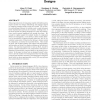5054 search results - page 37 / 1011 » How designers design and program interactive behaviors |
DATE
2006
IEEE
15 years 5 months ago
2006
IEEE
Enhancing productivity for designing complex embedded systems requires system level design methodology and language support for capturing complex design in high level models. For ...
GROUP
2007
ACM
15 years 3 months ago
2007
ACM
To improve existing social bookmarking systems and to design new ones, researchers and practitioners need to understand how to evaluate tagging behavior. In this paper, we analyze...
101
click to vote
CHI
2007
ACM
15 years 3 months ago
2007
ACM
Do human-human social interactions carry over to humanvirtual human social interactions? How does this affect future interface designers? We replicated classical tests of social i...
ATAL
2003
Springer
15 years 5 months ago
2003
Springer
Commitments model important aspects of agent interactions, especially those arising in e-business. A small number of patterns of commitments accommodate a variety of realistic int...
OOPSLA
2010
Springer
14 years 10 months ago
2010
Springer
General purpose object-oriented programs typically aren’t embarrassingly parallel. For these applications, finding enough concurrency remains a challenge in program design. To ...




